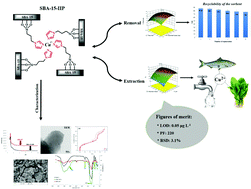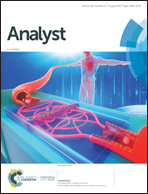Synthesis of ion-imprinted polymer-decorated SBA-15 as a selective and efficient system for the removal and extraction of Cu(ii) with focus on optimization by response surface methodology
Abstract
Ion-imprinted polymer-decorated SBA-15 (SBA-15-IIP) for the adsorption of copper was synthesized and characterized using different techniques, including FT-IR, XRD, TG/DTA, SEM, BET, and TEM. It was used as a green, efficient and rapid sorbent for the removal of Cu(II) from aqueous solution. The effect of several parameters on the removal percentage of copper was studied using the central composite design. The equilibrium data were investigated using the Langmuir and Freundlich isotherm models, and found to be well-fitted by the Langmuir model with the maximum adsorption capacity of 322.58 mg g−1. The adsorption kinetics was investigated using four models, and found to be well-fitted by the pseudo-second-order model. Also, the recyclability of SBA-15-IIP was studied, and the results after 6 cycles demonstrated that SBA-15-IIP was a promising sorbent for the removal of Cu(II) from aqueous solution. Subsequently, SBA-15-IIP was used as an efficient and selective sorbent for the extraction of Cu(II). Various parameters affecting the extraction efficiency of the analyte were investigated and optimized using the Box–Behnken design. The optimized methodology presented good linearity between 0.2 and 100 μg L−1 (R2 > 0.9946) and a detection limit of 0.05 μg L−1. The method had an enhancement factor of 220 and relative standard deviation (RSD) of 3.1% and 4.5% for intra-day and inter-day, respectively.



 Please wait while we load your content...
Please wait while we load your content...